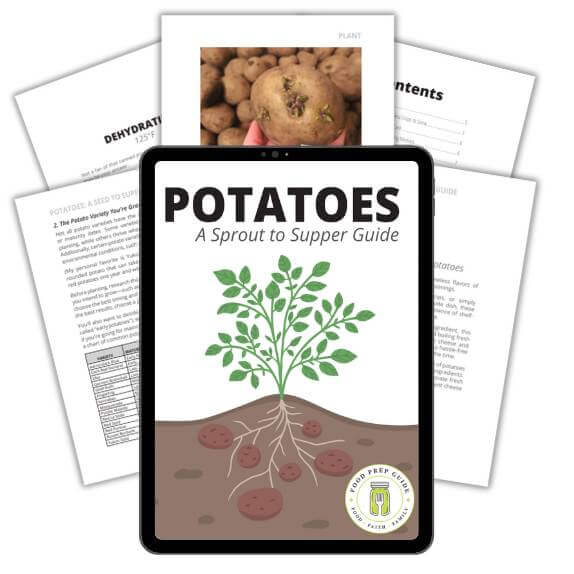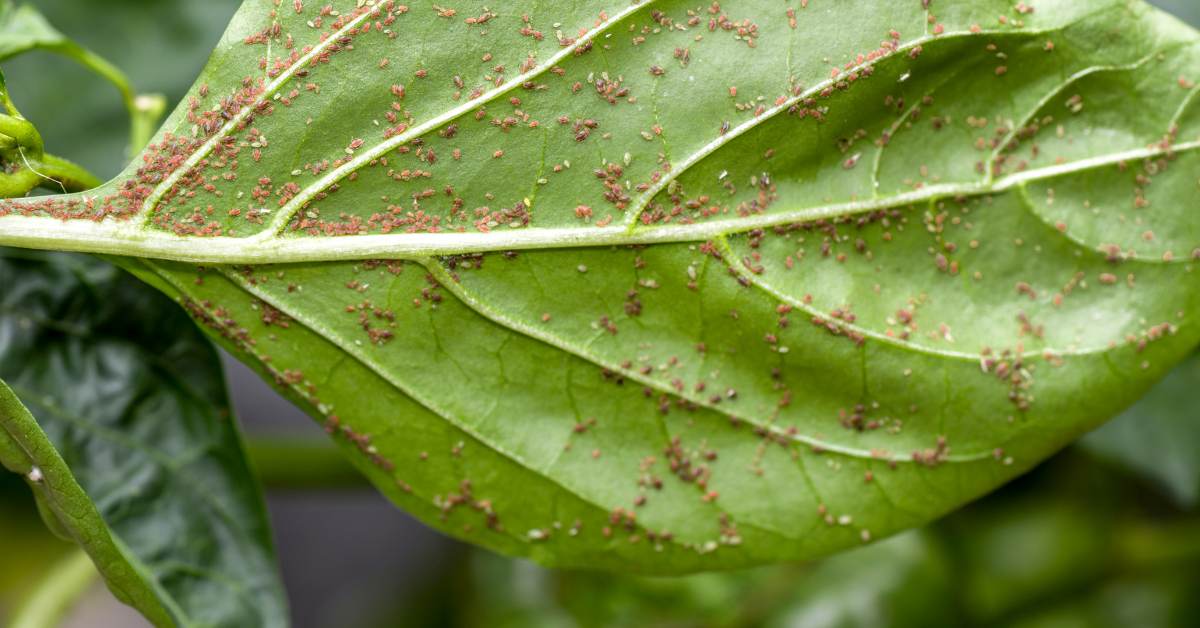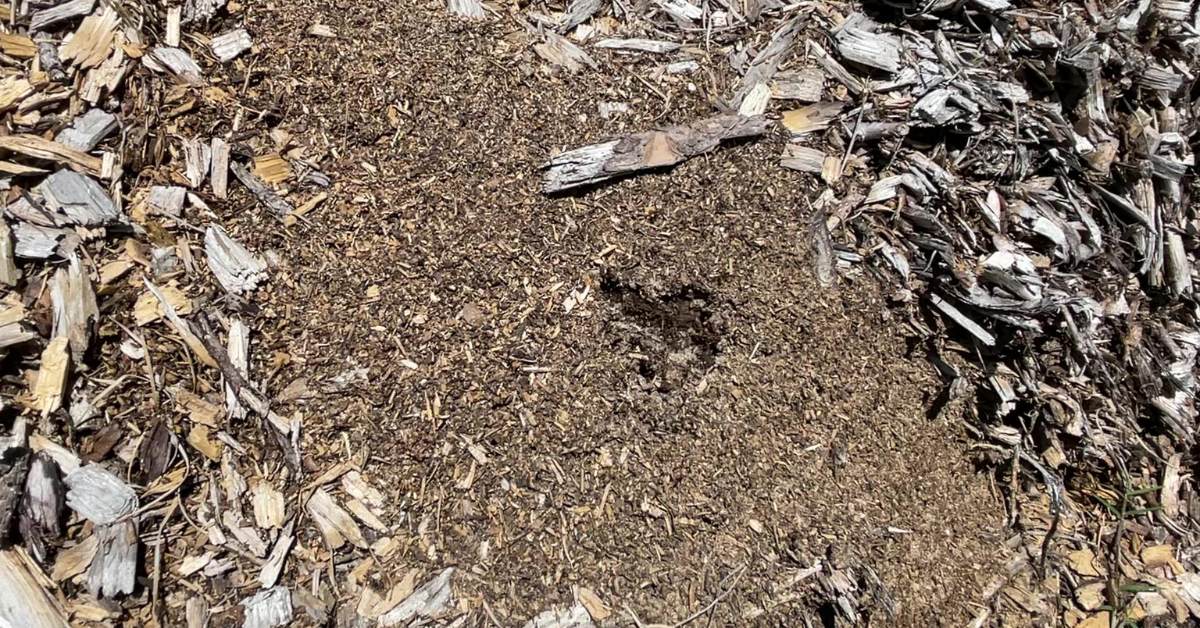As a newbie potato grower, I thought:
What if I harvest my potatoes too early?
Turns out … it’s not a big deal! When you harvest potatoes early, you simply have “new” or “baby” potatoes.
In fact, many people prefer the taste of new potatoes.
But if you want to maximize your yields and avoid disappointment over tiny taters, then you’ll want to understand the two primary stages of potato harvesting:
- Early Potatoes
- Maincrop Potatoes
Early Potatoes
Early potatoes are typically harvested when they are still fairly small and tender. These potatoes mature quicker than other varieties, don’t have to be planted as far apart, and take only around 55-90 days from planting to be ready for harvest.
To check if early potatoes are ready for harvest, gently probe the soil around the base of the plant with your fingers.
If you can easily find small, tender tubers, they are likely ready to be picked.
Keep in mind that early potatoes should be used soon after harvest. These potatoes are easy to grow, but they do not store well for extended periods.
Maincrop Potatoes
Maincrop potatoes take the longest time to mature. They generally require around 4-5 months from planting to be ready for harvest.
These potatoes are characterized by their larger size and thicker skin, making them perfect for winter storage.
To determine if your maincrop potatoes are ready for harvest, wait until the plant’s foliage starts to yellow and die back.
We have a complete tutorial for determining when your potatoes are ready to harvest.

Dream of Filling Your Pantry with Homegrown Staples?
Plan your garden with our FREE PRINTABLE—Staples Garden: What to Plant to Feed Your Family for a Year!
Gently dig around the base of the plant to check the size and development of the tubers. Harvesting maincrop potatoes too early may result in smaller tubers or a less robust flavor.
By understanding the different harvest stages for potatoes, you can ensure a successful and delicious crop for your garden.
As you grow potatoes, remember to pay close attention to their growth and development, and be patient when waiting for the perfect time to harvest.
Post-Harvest Practices
Sorting Out Your Potatoes
After harvesting your potatoes, it’s essential to sort them. Separate the damaged, small, or diseased tubers from the healthy ones. Damaged or diseased potatoes can cause rot and spoil the rest of your harvest during storage.
- Size: Arrange potatoes by size; this helps to ensure even storage conditions.
- Damage: Inspect for cuts, bruises, or any external damage.
- Disease: Look out for signs of disease like mold or pests.
Curing Potatoes
Curing potatoes is a crucial step to help them store longer. It helps to thicken the skins, allowing them to store better and prevent spoilage. (If possible, stop watering your potatoes about a week before harvesting.)
To cure your potatoes:
- Temperature: Place them in a room with a temperature around 50-60°F (10-15°C)
- Humidity: Maintain a high humidity, ideally around 85-90%
- Duration: Allow the potatoes to cure for 2-3 weeks
This process helps heal any minor damages in the potato skin and reduces the risk of rot.

Master Potatoes From Seed to Table
Get growing & preserving faster with no-fluff tutorials for every step from plant to plate!
Proper Storage Conditions
Once your potatoes have cured, it’s time to store them properly. The ideal storage conditions are:
- Temperature: Maintain a temperature between 40-45°F (4-7°C) for optimal storage. Lower temperatures can cause the starch to convert to sugar, resulting in sweeter potatoes.
- Humidity: Ensure high humidity levels, approximately 85-95%. This helps prevent dehydration and shriveling of the potato.
- Ventilation: Good airflow is necessary to prevent the accumulation of carbon dioxide, which can promote rot.
- Darkness: Store potatoes in a dark area, as exposure to light can cause them to turn green and develop a bitter taste.
Side Note: If you’re not happy with this year’s yields, focus on soil health next year. That’s the key to growing large potatoes. Here’s our guide for the best soil types for potatoes.
You may also need to time your planting better for higher yields. Check out our guide for when to plant potatoes for best results.
Frequently Asked Questions
Can you eat freshly dug potatoes?
Yes, you can eat freshly dug potatoes. In fact, new potatoes are a delicious treat enjoyed by many gardeners.
These small, tender potatoes have thin skins and a creamy texture. Simply wash them well to remove any dirt and cook them as you prefer, whether it’s boiling, steaming, or roasting.
Just remember that freshly dug potatoes will not store well, so eat them within a few days of harvesting.
How do I know when potatoes are ready?
To determine if your potatoes are ready for harvest, pay attention to the plant’s growth stage. For new potatoes, harvest about a week after plants start to flower.
For main-crop or storage potatoes, wait until the plant’s foliage begins to turn yellow and die back. It’s important to be patient, as harvesting too early may result in smaller and less flavorful potatoes.
Get our complete guide to what potatoes look like when they’re ready to harvest here.
When should I harvest container potatoes?
Container-grown potatoes follow the same general guidelines for harvest time, with new potatoes harvested when plants flower and main-crop potatoes when the foliage dies back.
However, you may want to check the specific maturity time for the variety you’re growing, as some container-friendly varieties don’t take as long to grow. A simple way to check for readiness is to gently dig around the edges of the container with your hands to feel for the size of the potatoes.
Can potatoes be left in the ground over winter?
In mild climates, it’s possible to leave potatoes in the ground over winter, especially if you provide a layer of mulch to protect them from frost.
However, this approach comes with risks, as wet soil and freezing temperatures can cause the potatoes to rot or develop diseases.
In areas with harsh winters, it’s best to harvest your potatoes and store them in a cool, dark, and well-ventilated place to ensure their longevity.










